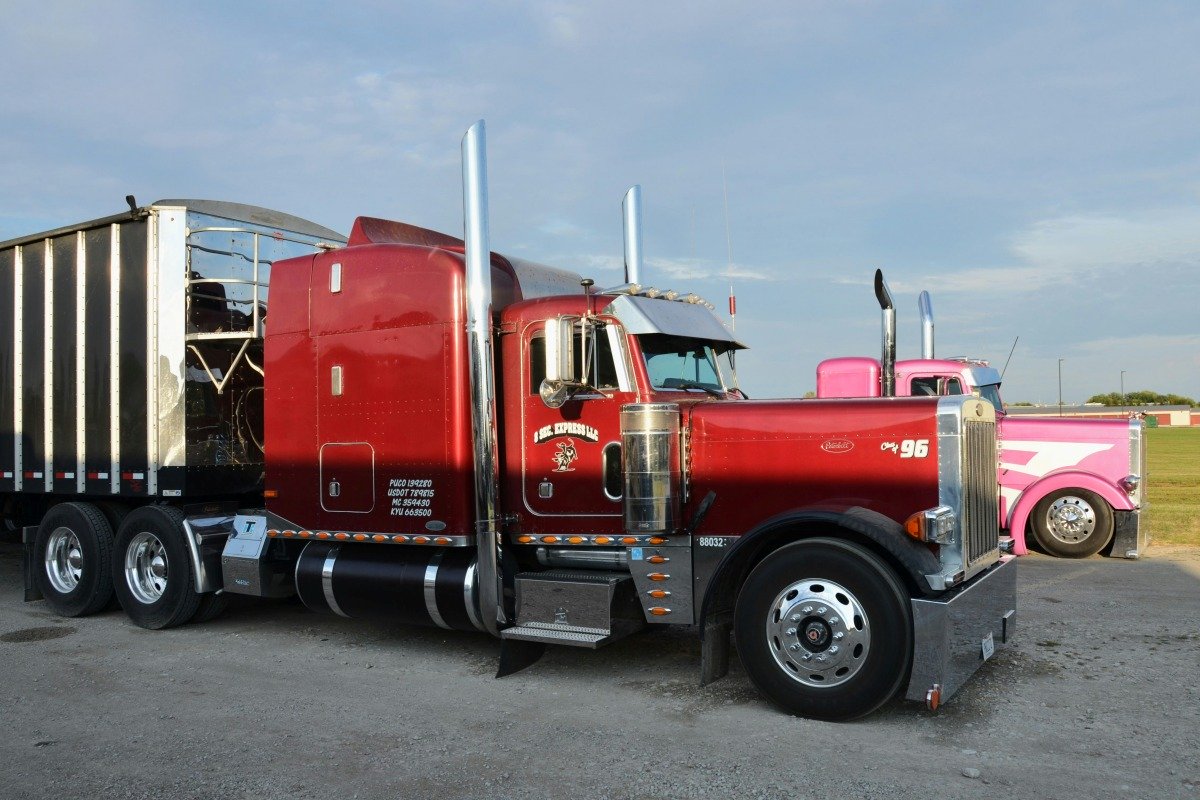Commercial truck insurance is one of the largest operating expenses you face as an owner-operator or fleet manager. Rising premiums in recent years reflect higher repair costs and stricter safety requirements.
The average monthly cost for for-hire transport trucks is about $954, or more than $11,000 annually. Total coverage ranging anywhere from $3,500 to over $20,000 per year per truck, depending on the state, type of cargo, and driving history.
Understanding where these numbers come from can help you choose the right coverage and avoid overpaying for policies that don’t fit your business needs.
What Is Commercial Truck Insurance?
Commercial truck insurance is a specialized type of commercial auto coverage designed to protect you, your equipment, and the freight you haul.
Unlike standard commercial auto insurance, truck insurance is specifically tailored for Class 8 tractors, box trucks, semi-trucks, and specialty vehicles that face unique risks on the road.
Commercial truck insurance combines multiple policies (liability, physical damage, cargo, and non-trucking coverage) into a single package that meets federal and state requirements.
The Federal Motor Carrier Safety Administration (FMCSA) requires all for-hire truckers to carry minimum liability coverage, and most shippers and motor carriers require additional protection before you can haul loads.
This isn’t optional. Operating without the right truck insurance exposes you to fines, suspensions, and even loss of operating authority.

What Is the Cost of Different Types of Commercial Insurance Coverage?
The cost of commercial truck insurance depends heavily on the type of coverage you choose. Some policies are required by law, while others are optional but critical to protecting your business from major losses.
Below are the most common types of coverage and what you can expect to pay in 2025 and beyond.
Primary Liability Coverage
Primary liability insurance is mandatory for all trucking businesses. It protects against bodily injury and property damage caused by your truck in an accident.
Owner-operators with authority (meaning you operate under your own FMCSA motor carrier number and carry all required insurance yourself) pay around $954 per month, or about $11,500 annually. If you’re leased to a motor carrier, that carrier usually provides primary liability on your behalf.
Physical Damage Coverage
Physical damage protects your truck and trailer against collision, theft, vandalism, and weather damage.
Premiums vary based on equipment value, but when combined with other required policies, the average total annual cost of insuring a Class 8 truck typically falls between $8,000 and $12,000.
If you finance or lease your truck, your lender will likely require physical damage insurance.
General Liability Coverage
General liability covers accidents and injuries that aren’t directly caused by your truck. For example, if a customer slips and falls at your office, this policy helps cover medical bills.
While standalone premiums can start as low as $600 annually, most trucking businesses purchase higher coverage limits or bundle general liability with other policies to save on overall costs.
Non-Trucking Liability Coverage
Non-trucking liability protects you when you drive your semi for personal reasons, not business. Say you take your truck to the store or run personal errands after dropping off a load. If you cause an accident, this coverage applies.
Premiums generally range from $400 to $1,600 annually, depending on your driving record and state requirements.
While it’s not legally required everywhere, most leased owner-operators need it to stay compliant with carrier contracts.

Bobtail Insurance
Bobtail coverage applies when you’re driving your tractor without a trailer, whether you’re on the way to pick up a load or heading home after a delivery. Most motor carriers require leased drivers to carry this policy.
You can expect to pay around $400 to $600 annually for bobtail insurance. Although it’s a relatively small expense compared to other coverages, it’s essential for avoiding uncovered liability when you’re operating without a trailer.
Motor Truck Cargo Insurance
Cargo insurance protects the freight you haul against theft, damage, or loss in transit. Coverage limits vary widely, with many shippers requiring at least $100,000 in protection. Some contracts demand up to $1 million in coverage, particularly for high-value or hazardous loads.
Premiums usually range from $1,000 to $4,000 per year, depending on cargo type and risk profile. Without this policy, a single damaged or stolen load could put your entire business at risk.
Umbrella Insurance
Umbrella insurance provides an extra layer of liability protection beyond your standard policies. It kicks in if a major accident or lawsuit exceeds the limits of your primary liability coverage.
For example, if damages total $1.5 million but your liability policy only covers $1 million, umbrella insurance can fill that gap.
The average cost for trucking umbrella insurance runs $5,000 to $7,000 per year, though actual premiums depend on your operation, routes, and claims history. Considering the rise in large jury verdicts against carriers, many fleets choose this additional coverage to safeguard against catastrophic losses.

How Much Does Commercial Truck Insurance Cost for Different Types of Drivers?
The price you pay for commercial truck insurance isn’t only about the truck itself. It’s also tied to your role in the industry. Whether you’re brand new with a Commercial Drivers License (CDL), running under your own authority, leasing onto a carrier, or managing a fleet, the numbers vary.
Here’s what you can expect.
New CDL Drivers
Financing as a new CDL driver will likely be your single biggest expense in year one. Insurers see new drivers as high risk due to limited experience, which drives up premiums. First-year drivers with authority can pay $12,000 to $16,000 annually for full coverage.
You can lower costs by taking safety courses, joining an association, or starting under a lease with an established carrier until you build experience. A clean driving record over the first two years will dramatically improve your rates.
Owner-Operators With Authority
When you operate under your own authority, you’re responsible for carrying all required coverages, including primary liability, cargo, and physical damage. On average, owner-operators pay between $9,000 and $16,000 annually per truck, depending on location, cargo, and driving record.
While these costs are higher than leased drivers face, having your own authority gives you more freedom to negotiate contracts, choose loads, and grow your business on your terms.
Leased Owner-Operators
If you’re leased to a motor carrier, the carrier typically covers your primary liability, which significantly lowers your insurance costs. You’ll still need bobtail, non-trucking liability, and possibly physical damage coverage.
Most leased owner-operators spend between $2,000 and $4,000 annually for these supplemental policies. This is one of the most affordable ways to get started in the industry, especially if you’re still building credit or saving capital for your own authority.
Small Fleet Owners
Running a small fleet (two to ten trucks) comes with higher costs overall, but you may qualify for bulk discounts if you insure all vehicles together. Fleet insurance is often quoted on a per-truck basis, and premiums vary widely by state and cargo type.
On average, small fleet owners pay $10,000 to $20,000 annually per truck, with higher-risk operations reaching even more. Bundling multiple coverages and maintaining strong safety programs can help you control these costs and keep your business competitive.

Average Semi-Truck Insurance Costs by State
Insurance premiums for semi trucks vary dramatically depending on where you operate. Local laws, traffic density, litigation climate, and even weather risk all push rates higher or lower.
Here’s how five key state insurance costs compare, and what that means for you:
- Texas ($10,533): Running a truck in Texas puts you in the mid-to-higher tier. This rate reflects heavy traffic corridors, oilfield operations, and high claims activity.
- California ($11,834): With dense urban freight, strict regulations, and expensive liability risks, California tends to push your insurance costs upward.
- Florida ($12,872): Exposure to hurricanes, theft, and complex freight routes combine to make Florida one of the costlier places to insure a semi truck.
- Georgia ($15,200): Georgia’s high rate is driven by aggressive liability judgments and freight flow-intensity through its transportation hubs.
- New Jersey ($20,763): At the high end, New Jersey reflects dense industrial corridors, high litigation exposure, and tight regulatory environments.
Operating in one of the higher-cost states means your insurance allotment must be not just sufficient, but built into every haul. If your freight contracts or route options let you choose where you register or base your trucks, these state cost differentials become strategic levers.
Also, if your operation crosses state lines, you’ll often carry the higher rate or face surcharges if servicing a more expensive jurisdiction. Knowing the “home state” baseline helps you anticipate premiums and avoid surprise cost jumps.
Other Factors Affecting Semi-Truck Insurance Costs
Beyond coverage type and driver status, many external and operational elements influence what you’ll pay in insurance premiums. Understanding these variables gives you leverage to reduce costs and negotiate better terms.
Liability Risks and Legal Environment
You pay not just for routine claims but also face large verdicts and litigation trends. Over the past few years, “nuclear verdicts” (jury awards exceeding $10 million) have pushed insurers to raise premiums across the board.
In 2024, social inflation and escalating lawsuit costs have become major drivers of rate increases. Because of these legal pressures, insurers price in higher risk. If your fleet operates in states with aggressive jury climates or few tort reforms, your base premium will reflect that.
Operational Costs and Inflation
Insurers pass the rising costs of repairs, labor, and claims onto drivers. In 2024, many trucking companies saw premium hikes of 12.5% or more, driven by higher parts costs, labor inflation, and rising claims severity.
Also, inflation affects the total cost of claims (medical bills, legal fees), pushing insurers to factor higher future exposure into current premiums.

Cargo Type, Route Risk, and Operating Radius
What you haul and where you haul it matter a lot. If you transport hazardous materials or high-value freight, insurers treat your operation as higher risk because the potential losses are greater and the cost of a single claim can be massive.
A spill of hazardous cargo can trigger environmental cleanup and lawsuits, while stolen electronics or luxury goods can cost hundreds of thousands of dollars in one incident.
Routes through high-density areas or regions with elevated theft rates or adverse weather also command higher premiums. Distance and route complexity directly raise your risk exposure and, therefore, your premium.
Driver Record, Experience, and Safety Programs
Your drivers are the first line of risk control. Insurers examine accident history, violation records, and years behind the wheel. Clean records and long experience reduce your risk profile.
Investing in driver training and adopting trucking telematics or ELD data sharing can qualify you for discounts. Those safety measures provide real proof to insurers that risk is controlled.
Vehicle Age, Equipment, and Safety Features
Newer trucks with advanced safety systems (collision avoidance, lane assist, electronic stability) are less of a liability in insurer models. Older trucks without modern safety gear attract higher premium rates.
Also, customized or heavily modified rigs often cost more to insure, because replacement parts and collision repairs become more complex.
Claims History and Loss Ratio
Insurers dig deep into your history of claims. Frequent small losses or one major claim raise your risk score.
If your loss ratio is high (i.e., claims eat up a lot of premiums), you’re more likely to see premium hikes. Consistency matters. A single catastrophic accident can create a spike in your rates for years beyond the incident.
Credit Score and Financial Stability
Many insurers review your business credit or your personal credit history. A stable credit profile suggests you’re less likely to default or under-report risk, so you may get better rates. Poor credit may lead to surcharges or reduced options.

Geographic Location and State Regulations
Where your trucks are registered and where they operate drives premium differences. States differ in minimum insurance mandates, tort laws, and local claim climates.
For example, states with more aggressive lawsuit environments or high accident rates command higher rates. Additionally, routes crossing into those states can raise your rate or trigger surcharges.
Regulatory and Industry Trends
New regulations, such as mandates for safety tech, emissions standards, or minimum coverage limits, can increase insurance baseline costs. Compliance burdens push insurers to raise premiums.
Emerging threats such as cargo theft, supply chain vulnerabilities, and cyber risk are also drawing underwriter attention, pushing the price of insurance upward.
Tips for Reducing Insurance Costs and Keeping Them Low
Once you’ve secured a policy, keeping premiums manageable requires consistent effort. These practical steps help you show insurers that your operation is lower risk, which translates to long-term savings:
- Maintain a clean driving record: Fewer violations and accidents directly lower your risk profile and premium.
- Monitor credit reports: Strong business or personal credit often qualifies you for better rates.
- Optimize routes: Reduce unnecessary mileage and limit exposure to high-risk corridors.
- Bundle coverage: Combine liability, cargo, and physical damage policies for discounts.
- Ask about fleet programs: Insuring multiple trucks together usually earns volume savings.
- Invest in safety technology: Telematics, dash cams, and electronic logging devices can qualify you for rate reductions.
- Join associations: Membership in trucking associations or verified safety programs improves your risk rating.
- Adjust deductibles: Higher deductibles mean lower premiums if you have the cash flow to cover occasional claims.
- Review coverage annually: Updating policies as your business grows ensures you’re not overpaying for outdated limits.

Conclusion
Commercial truck insurance is one of your largest ongoing expenses, but it’s also one of the most critical protections for your business. Whether you’re a new CDL driver facing higher premiums or a small fleet owner trying to keep trucks on the road, understanding coverage types and cost factors helps you stay prepared.
Premiums from $3,500 to over $20,000 per truck annually, managing insurance is about more than compliance – it’s about protecting your livelihood. With the tips above, you can keep costs under control without sacrificing coverage.
Mission Financial Services is here to help truckers like you navigate financing and keep your business moving forward.
If you’re ready to take control of your operating costs and secure the right coverage for your trucks, start your credit application with Mission Financial Services today.


